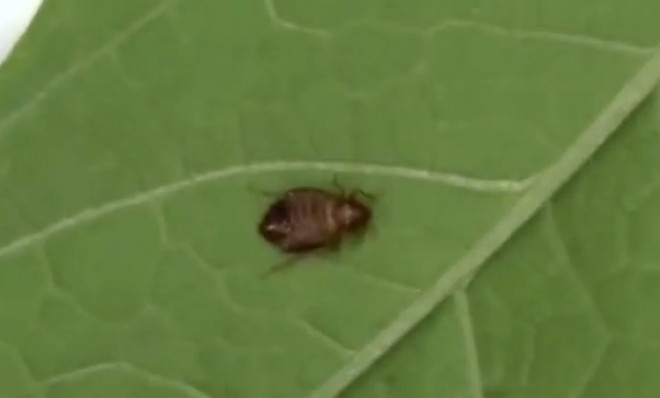WATCH: A humble bean leaf conquers the bedbug
The dreaded bloodsucking parasite is impervious to most pesticides, but a Balkan folk remedy may finally vanquish the bedbug


Humanity has been engaged in a high-profile war against bedbugs for several years now, and the bedbugs are winning handily. They're resistant to most modern chemicals — bedbugs outgrew our old miracle cure, DDT, in the 1960s — and the main alternative, heat, is only sometimes effective at killing an infestation of the bloodsucking pests.
That's left homeowners, hoteliers, and even high-end retailers in the U.S. and around the world waging expensive, disruptive, sometimes futile, and always disheartening campaigns to free themselves from the bedbug scourge. The surprising answer to our bedbug problem, it turns out, may be the humble leaves of a kidney bean plant, and the wisdom of 19th-century housewives in the Balkans. (See video above.)
"Generations of Eastern European housewives doing battle against bedbugs spread bean leaves around the floor of an infested room at night," says Felicity Barringer in The New York Times. "In the morning, the leaves would be covered with bedbugs that had somehow been trapped there. The leaves, and the pests, were collected and burned — by the pound, in extreme infestations."
The Week
Escape your echo chamber. Get the facts behind the news, plus analysis from multiple perspectives.

Sign up for The Week's Free Newsletters
From our morning news briefing to a weekly Good News Newsletter, get the best of The Week delivered directly to your inbox.
From our morning news briefing to a weekly Good News Newsletter, get the best of The Week delivered directly to your inbox.
Brooke Borel at Popular Science notes that using kidney bean leaves to deter bedbugs dates back to at least 1678, when English philosopher John Locke promoted the tactic, and a German entomologist gave some credence to the folk remedy in 1927, wrongly suggesting that the leaves stunned the bedbugs. U.S. researchers came closer to the truth in 1943, when they reported that the bugs were being trapped by microscopic plant hairs called trichomes — but the brutal effectiveness of DDT and the distraction of World War II consigned their research to an obscure footnote in the annals of bedbug warfare.
Researchers from the University of California, Irvine, and University of Kentucky are bringing the old Balkan anti-bedbug technique back to the forefront — and possibly into the modern age. On Tuesday, they reported in the Journal of the Royal Society Interface that bedbugs aren't just trapped on the leaves, they're impaled, left to die when the trichomes pierce vulnerable spots in the bedbugs' exoskeleton, where their legs bend and claws meet the foot. Usually by six steps, the bugs are pinned to the leaf.
"Of course, keeping fresh bean leaves on hand isn't an easy bed bug fix," says Popular Science's Borel. Lead researcher Catherine Loudon, a UC-Irvine physical biologist, wryly notes that "the inconvenience of bean leaves is that not everyone wants them scattered around their bedroom." So her team is trying to develop a synthetic replica of the leaves to put around beds and other areas to trap and kill the bedbugs. In their efforts so far, the natural leaves have performed much better.
"The scientists, though, think they know what needs to be done," says The New York Times' Barringer.
A free daily email with the biggest news stories of the day – and the best features from TheWeek.com
And they are far from giving up. As they wrote in the study, "With bedbug populations skyrocketing throughout the world and resistance to pesticides widespread, bio-inspired microfabrication techniques have the potential to harness the bedbug-entrapping power of natural leaf surfaces." Or as Dr. Loudon said, "It would be our greatest hope that ultimately this could develop into something that could help with this horrible problem." Already, she said, she and her colleagues have a patent on the technology pending. It has, she said, been optioned by a commercial company. [New York Times]
The research has its skeptics. "In a bedroom there are hundreds of nooks and crannies where bedbugs can hide — they even get into the crevices of the telephone and alarm clock," Ian Burgess, of Britain's Medical Entomology Center tells BBC News. "Bedbugs move around walls, across the ceiling — you could try to create a barrier around the bed, but it is questionable how effective this would be." James Logan, an entomologist at the London School of Hygiene and Tropical Medicine, adds that a synthetic kidney bean leaf could make for a really useful monitoring tool, but notes that his researchers "are working on making traps with pheromones that entice bedbugs to the trap — otherwise you are just waiting for them to stumble across it."
Logan is right — "a bedbug trap only works if a bedbug actually walks through it," says Popular Science's Borel. So the kidney bean leaf probably won't be the bedbug silver bullet we've all been looking for. But we should welcome the research anyway. "It is unlikely that even a crafty biomimetic material will be a final solution for a bedbug infestation, but instead one part of an approach that may include heat, steam, vacuuming, and insecticides." In this battle against the bedbug, any new — or newly rediscovered — tool counts.
Peter has worked as a news and culture writer and editor at The Week since the site's launch in 2008. He covers politics, world affairs, religion and cultural currents. His journalism career began as a copy editor at a financial newswire and has included editorial positions at The New York Times Magazine, Facts on File, and Oregon State University.
-
 Will regulators put a stop to Grok’s deepfake porn images of real people?
Will regulators put a stop to Grok’s deepfake porn images of real people?Today’s Big Question Users command AI chatbot to undress pictures of women and children
-
 ‘All of these elements push survivors into silence’
‘All of these elements push survivors into silence’Instant Opinion Opinion, comment and editorials of the day
-
 A running list of US interventions in Latin America and the Caribbean after World War II
A running list of US interventions in Latin America and the Caribbean after World War IIin depth Nicolás Maduro isn’t the first regional leader to be toppled directly or indirectly by the US
